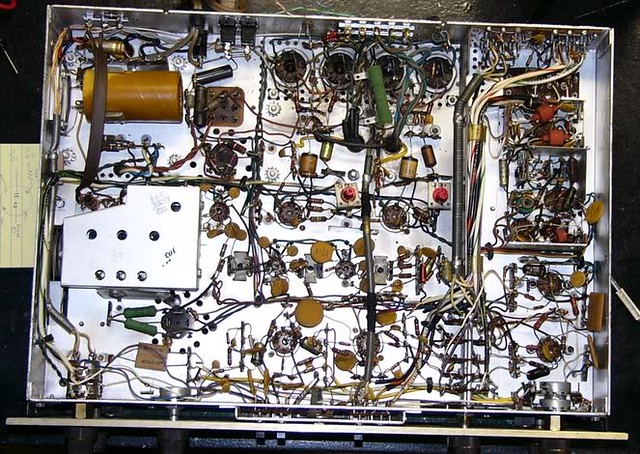Anyone interested in looking inside Yamaha amps? I have a bunch in my collection, most of them need repair, all of them have to be opened eventually for dusting.
I'll start with some pictures i made inside a A-S1000 that i bought for 500€ in mint condition. This one weighs 25kg, it's a serious amp. For example, if you move the bass knob from 0, a relay clicks and adds it into the signal path. A bit of dust inside and a black sharpie marking on the volume knob was all that was wrong with it. The amp was about 11 years old when i got it, i eventually ugraded to a A-S1200 and sold this one for 600€. To me it sounded just as good as the A-S1200, but lacks standby and VU meters.
Not a scratch. Very large, heavy and deep:

Wood panels in piano finish:

Brass terminals:

There is a thick metal bridge that makes sure the amp reaches peak robustness:

The amp is made almost fully symmetric. The yellow stuff on the transformer bugged me a bit, it was hardened lacquer. Every cable is tied down with cable ties. Nothing can move.

Yamaha labelled caps, made by Nippon Chemi-Con Corporation, the largest manufacturer of electrolytic capacitors (not to be confused with Nichicon):

From left to right, bass, treble, balance and volume. The ICs don't get energy as long as the treble is set to 0 for example. If you change the treble to +1 or -1, a relay clicks and powers those chips. The volume knob doesn't change the volume, but gives a resistor value to this board, which then changes the volume. Should be easy to repair once the variable resistor goes bad in 20 or so years:

And here the left channel power amp:

Since i don't have the device anymore, i can't make new detailed pics, but i can of course give details on what you can see here. I had to heavily shrink the pictures down.
If there is interest, tell me, next would be a comparison of Yamaha A-S501 and A-S701.
I also have the R-S202D, A-S300, RX-300, A-550, RX-10, AX-10 and of course the A-S1200.
I'll start with some pictures i made inside a A-S1000 that i bought for 500€ in mint condition. This one weighs 25kg, it's a serious amp. For example, if you move the bass knob from 0, a relay clicks and adds it into the signal path. A bit of dust inside and a black sharpie marking on the volume knob was all that was wrong with it. The amp was about 11 years old when i got it, i eventually ugraded to a A-S1200 and sold this one for 600€. To me it sounded just as good as the A-S1200, but lacks standby and VU meters.
Not a scratch. Very large, heavy and deep:
Wood panels in piano finish:
Brass terminals:
There is a thick metal bridge that makes sure the amp reaches peak robustness:
The amp is made almost fully symmetric. The yellow stuff on the transformer bugged me a bit, it was hardened lacquer. Every cable is tied down with cable ties. Nothing can move.
Yamaha labelled caps, made by Nippon Chemi-Con Corporation, the largest manufacturer of electrolytic capacitors (not to be confused with Nichicon):
From left to right, bass, treble, balance and volume. The ICs don't get energy as long as the treble is set to 0 for example. If you change the treble to +1 or -1, a relay clicks and powers those chips. The volume knob doesn't change the volume, but gives a resistor value to this board, which then changes the volume. Should be easy to repair once the variable resistor goes bad in 20 or so years:
And here the left channel power amp:
Since i don't have the device anymore, i can't make new detailed pics, but i can of course give details on what you can see here. I had to heavily shrink the pictures down.
If there is interest, tell me, next would be a comparison of Yamaha A-S501 and A-S701.
I also have the R-S202D, A-S300, RX-300, A-550, RX-10, AX-10 and of course the A-S1200.
Last edited:

 Knight333underneath
Knight333underneath Richards400belowbefore
Richards400belowbefore Marantz8Bbefore
Marantz8Bbefore